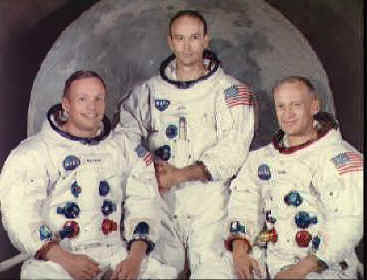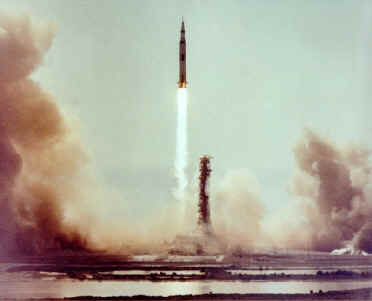
|
|
|
Shuttle Crew Commander Neil A. Armstrong Command Module Pilot Michael Collins Lunar Module Pilot Edwin E. Ervin
Back-up Crew Commander James Lovell Command Module Pilot William A. Anders Lunar Module Pilot Fred Haise
|

|
||
|
Neil and the american flag.
|
Launched 16 July 1969 UT 13:32:00 (09:32:00a.m EDT) Landed on Moon 20 July 1969 UT 20:17:40 (04:17:40 p. m. EDT) Landing Site Mare Of Tranquilitatis -Sea Of Tranquility (0.67N, 23.4E.) Returned to 24 July 1969 UT 16:50:35 (12:50:35pm EDT)
|
||
|
Mission Plan for NASA's Apollo 11. Land two men on the Lunar Surface and return them safely to Earth.
|
|||
|
Landing Site The first ever manned spacecraft landing on Moon was at 3:17 pm EST on July 20, 1969. Apollo 11's Lunar Module the Eagles landing site was the Sea of Tranquility, located at 0degrees4'5" N Latitude, 23 degrees 42'28" E Longitude. The Eagle would land approximately 50 kilometers from the nearest highland material and approximately 400 meters West of a 188 meter in diameter sharp-rimmed blocky crater.
Aldrin would instantly start explaining the view from the window "...it looks like a collection of just about every variety of shapes, angularities and granularities, every variety of you could find ....it looks as though they're going to have some interesting colors to them. |
|||
|
The Ship
Morning of July 16, 1969 launch day. The 60-ton Saturn 5 Rocket was given a detailed inspection on its launch pad (39-A) location Kennedy Space Center (Cape Canaveral). On board the ship was four and a half tons of Rocket fuel, and a spider shaped covered in gold and silver foil spaceship. |
On top picture of the 60 ton Saturn-5 Rocket. At left the Apollo 11 blast of from NASA. |
||
 |
|||
|
The Apollo 11 Mission
Approximately 75 hours and 50 minutes after taking off from Earth. The crew of Apollo 11 entered lunar orbit only something two other missions had accomplished. Each orbit took the crew closer to their final destination and that was the Sea Of Tranquility. The Sea of Tranquility was the surface near the equator that would be lit by the Sun when the last approach commenced. During the 13th orbit around the Moon Aldrin, Armstrong and, Collins commenced their final voyage into the unknown territory.
Sunday July 20th the crew of Apollo 11 were awakened after a restless night's rest. Finishing a short breakfast Aldrin and Armstrong climbed through the tunnel connecting the spaceship with the Eagle. They then entered the Eagle. " Buzz Aldrin, Now you crawl through the tunnel as you're going towards the Moon, you crawl through tunnel and go up through the ceiling, you go through the hatch, now all of a sudden, bingo you're coming down through the ceiling. And everything is twisted sideways now to me that was exhilarating, maybe it was notable, it was curiously different." For Neil Armstrong and Buzz Aldrin, life would soon be a lot more curious than that. With the flick of a switch Collins unattached the Eagle from the mother ship, the voyage to the Moon's surface had begun.
Gene Kranz NASA Flight Director, Apollo 11, "We've now got two spacecrafts separately that we're working with independently. A part of my team is working with the manned service module, which is another ship continuing in lunar orbit. The other one which is the lunar module which we have checked out very meticulously as far as we can determine all systems are up and operating." With very little fanfare. The Eagle tuned the distant side of the Moon.
The members of Apollo 11 had a series of maneuvers they must perform upon their final lunar orbit. For the people at NASA there is no radio signals all they can do is wait. If the signal comes to early or to late even by just a second it would mean Aldrin and Armstrong had failed to obtain proper orbit. Which means the mission may have to be cancelled. But luckily communications were made exactly on time meaning the Eagle was on course. As they came closer to the surface of the Moon Armstrong took over the eagle so that he could manually land this historic event. Standing beside him Buzz Aldrin was providing him with all the data he would need to land safely on the moon. Providing things like how fast they were descending, distance to the surface, and how fast their forward speed was. Neil Armstrong only had one minute to find a land able place to set it down and options were quickly diminishing.
Then it happened man had landed on the moon. This was a big part of Kennedy's dreams that had been achieved. But the mission was a long way from over. The Apollo 11 crew still had to return safely back to Earth. But to the men and women of the United States the Eagle had passed with flying colors. Although a little bit of pressure build up in one of the fuel lines caused a few seconds of concern, the problem was soon fixed and Aldrin and Armstrong were told they could stay a while.
Gene Kranz "It wasn't enough to land people on the moon. You had to get something done while you were there, and then you had to bring this crew back safely."
Buzz Aldrin "Once we got there, then we could have the breathing time to contemplate what we would do next, and exiting the spacecraft was certainly a very major symbolic event."
But for all the millions of people watching this landing on TV around the world, was the main event. Yet they would have to wait six and a half hours to see man walk on the Moon because Aldrin and Armstrong were not about to rush through preparations. There was no doubt that Buzz Aldrin was ready to get outside. Aldrin had wanted to be the first man on the Moon months before they blasted off. Although Aldrin wanted to be number one. The Commander of this all important Apollo mission would be the first to set foot on the Moon. Aldrin's job was to help Armstrong out of the door. After all the proper instructions given Armstrong steps onto the Moon. Quote "That's one small step for man, one giant leap for mankind.
Gene Kranz, " If you manna talk pure joy, total euphoria I mean it was .... I was absolutely amazed. If anything, I was just totally enthralled. I don't think there's any of words that could get it. Pure joy, euphoria. I was in a dream world. I couldn't all this was happening.
15 minutes after Armstrong Aldrin became the second man on the Moon. Buzz, "Now I mant to partially close the hatch. Making sure not to lock it on the way out. A partially good thought." Armstrong and Aldrin performed some scientific experiments, they took hundreds of photos of the Lunar Suface and brought back 20 Kilograms of rocks.
Crews to come would spend days on the Moon. Aldrin and Armstrong got two hours an thirty-one minutes. Kenned had challenged Americans to make it to the Moon and return by the end of the sixties. The workers at NASA and the Apollo 11 crew had accomplished this with five months to spare.
|
|||